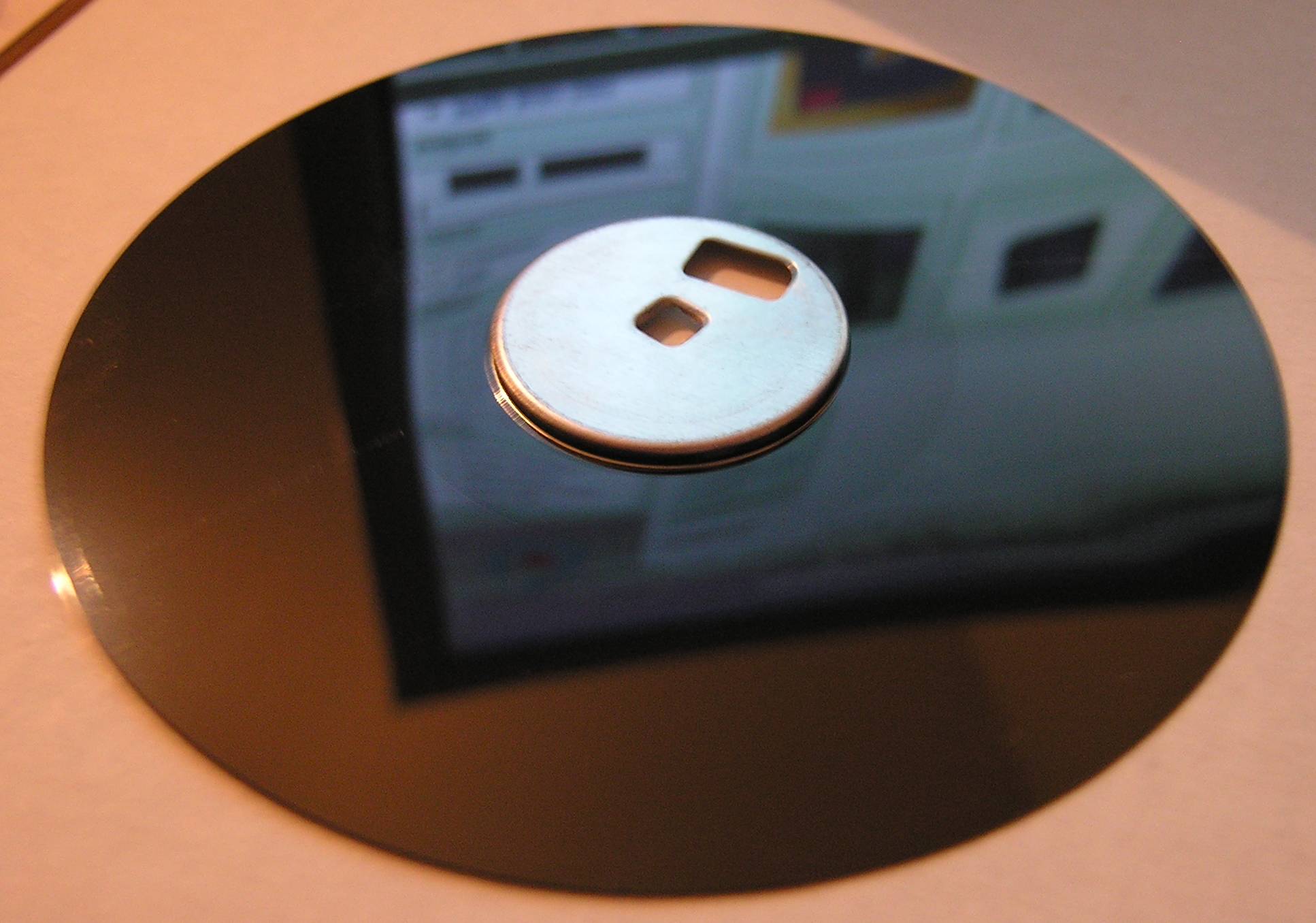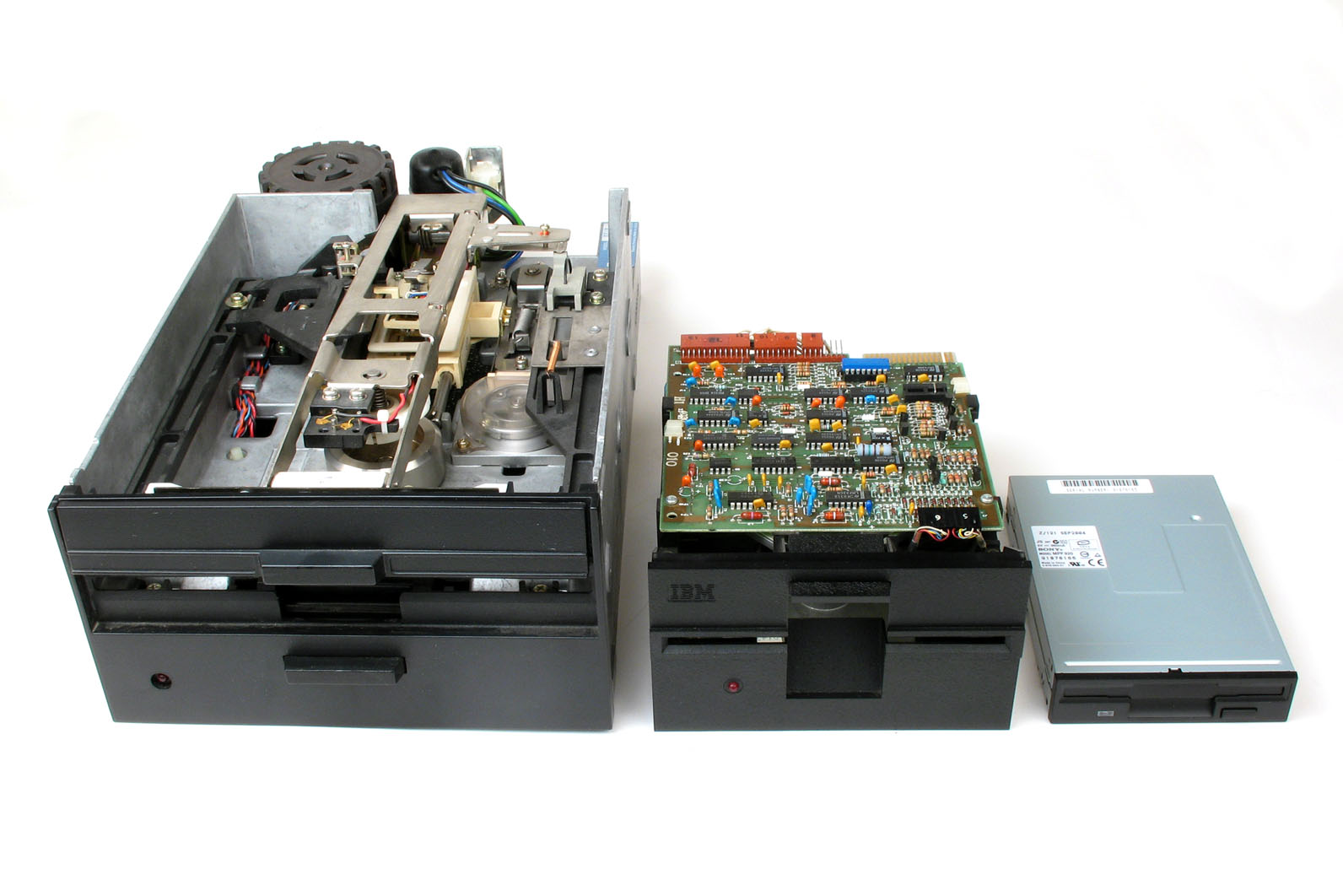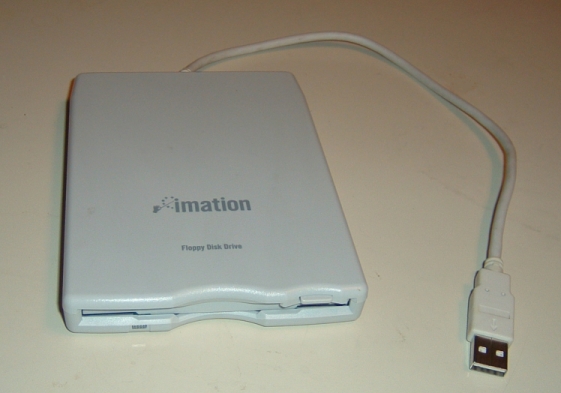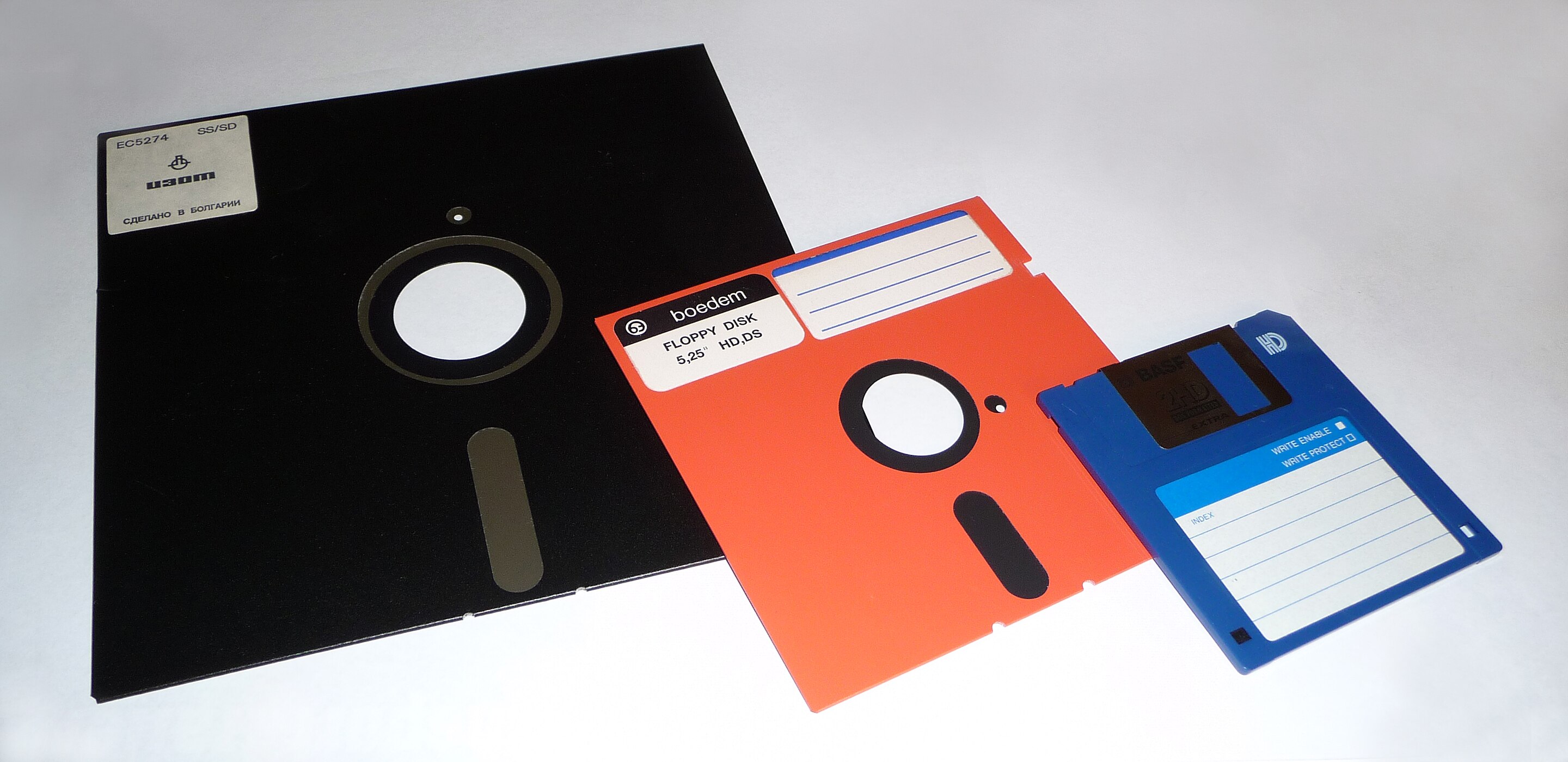A floppy disk or floppy diskette (casually referred to as a floppy, or a diskette) is an obsolescent type of disk storage composed of a thin and flexible disk of a magnetic storage medium in a square or nearly square plastic enclosure lined with a fabric that removes dust particles from the spinning disk. Floppy disks store digital data which can be read and written when the disk is inserted into a floppy disk drive (FDD) connected to or inside a computer or other device.
 |
| A 31⁄2-inch floppy disk removed from its housing |
Floppy disks were so common in late 20th-century culture that many electronic and software programs continue to use save icons that look like floppy disks well into the 21st century. While floppy disk drives still have some limited uses, especially with legacy industrial computer equipment, they have been superseded by data storage methods with much greater data storage capacity and data transfer speed, such as USB flash drives, memory cards, optical discs, and storage available through local computer networks and cloud storage.
History
The first commercial floppy disks, developed in the late 1960s, were 8 inches (203.2 mm) in diameter; they became commercially available in 1971 as a component of IBM products and both drives and disks were then sold separately starting in 1972 by Memorex and others. These disks and associated drives were produced and improved upon by IBM and other companies such as Memorex, Shugart Associates, and Burroughs Corporation. The term "floppy disk" appeared in print as early as 1970, and although IBM announced its first media as the Type 1 Diskette in 1973, the industry continued to use the terms "floppy disk" or "floppy".
 |
| 8-inch, 5+1⁄4-inch (full height), and 3+1⁄2-inch drives |
In 1976, Shugart Associates introduced the 5¼-inch FDD. By 1978, there were more than ten manufacturers producing such FDDs. There were competing floppy disk formats, with hard- and soft-sector versions and encoding schemes such as differential Manchester encoding (DM), modified frequency modulation (MFM), M2FM and group coded recording (GCR). The 5¼-inch format displaced the 8-inch one for most uses, and the hard-sectored disk format disappeared. The most common capacity of the 5¼-inch format in DOS-based PCs was 360 KB, for the Double-Sided Double-Density (DSDD) format using MFM encoding. In 1984, IBM introduced with its PC/AT the 1.2 MB dual-sided 5¼-inch floppy disk, but it never became very popular. IBM started using the 720 KB double density 3½-inch microfloppy disk on its Convertible laptop computer in 1986 and the 1.44 MB high-density version with the IBM Personal System/2 (PS/2) line in 1987. These disk drives could be added to older PC models. In 1988, Y-E Data introduced a drive for 2.88 MB Double-Sided Extended-Density (DSED) diskettes which was used by IBM in its top-of-the-line PS/2 and some RS/6000 models and in the second-generation NeXTcube and NeXTstation; however, this format had limited market success due to lack of standards and movement to 1.44 MB drives.
Throughout the early 1980s, limits of the 5¼-inch format became clear. Originally designed to be more practical than the 8-inch format, it was becoming considered too large; as the quality of recording media grew, data could be stored in a smaller area. Several solutions were developed, with drives at 2-, 2½-, 3-, 3¼-, 3½- and 4-inches (and Sony's 90 mm × 94 mm (3.54 in × 3.70 in) disk) offered by various companies. They all had several advantages over the old format, including a rigid case with a sliding metal (or later, sometimes plastic) shutter over the head slot, which helped protect the delicate magnetic medium from dust and damage, and a sliding write protection tab, which was far more convenient than the adhesive tabs used with earlier disks. The large market share of the well-established 5¼-inch format made it difficult for these diverse mutually-incompatible new formats to gain significant market share. A variant on the Sony design, introduced in 1982 by many manufacturers, was then rapidly adopted. By 1988, the 3½-inch was outselling the 5¼-inch.
Generally, the term floppy disk persisted, even though later style floppy disks have a rigid case around an internal floppy disk.
By the end of the 1980s, 5¼-inch disks had been superseded by 3½-inch disks. During this time, PCs frequently came equipped with drives of both sizes. By the mid-1990s, 5¼-inch drives had virtually disappeared, as the 3½-inch disk became the predominant floppy disk. The advantages of the 3½-inch disk were its higher capacity, its smaller physical size, and its rigid case which provided better protection from dirt and other environmental risks.
Prevalence
Floppy disks became commonplace during the 1980s and 1990s in their use with personal computers to distribute software, transfer data, and create backups. Before hard disks became affordable to the general population, floppy disks were often used to store a computer's operating system (OS). Most home computers from that time have an elementary OS and BASIC stored in read-only memory (ROM), with the option of loading a more advanced OS from a floppy disk.
By the early 1990s, the increasing software size meant large packages like Windows or Adobe Photoshop required a dozen disks or more. In 1996, there were an estimated five billion standard floppy disks in use. Then, distribution of larger packages was gradually replaced by CD-ROMs, DVDs, and online distribution.
 |
| Imation USB floppy drive, model 01946: an external drive that accepts high-density disks |
Gradual transition to other formats
In the mid-1990s, mechanically incompatible higher-density floppy disks were introduced, like the Iomega Zip disk. Adoption was limited by the competition between proprietary formats and the need to buy expensive drives for computers where the disks would be used. In some cases, failure in market penetration was exacerbated by the release of higher-capacity versions of the drive and media being not backward-compatible with the original drives, dividing the users between new and old adopters. Consumers were wary of making costly investments into unproven and rapidly changing technologies, so none of the technologies became the established standard.
Apple introduced the iMac G3 in 1998 with a CD-ROM drive but no floppy drive; this made USB-connected floppy drives popular accessories, as the iMac came without any writable removable media device.
Recordable CDs were touted as an alternative, because of the greater capacity, compatibility with
existing CD-ROM drives, and—with the advent of re-writeable CDs and packet writing—a similar reusability as floppy disks. However, CD-R/RWs remained mostly an archival medium, not a medium for exchanging data or editing files on the medium itself, because there was no common standard for packet writing which allowed for small updates. Other formats, such as magneto-optical discs, had the flexibility of floppy disks combined with greater capacity, but remained niche due to costs. High-capacity backward compatible floppy technologies became popular for a while and were sold as an option or even included in standard PCs, but in the long run, their use was limited to professionals and enthusiasts.
Flash-based USB-thumb drives finally were a practical and popular replacement, that supported traditional file systems and all common usage scenarios of floppy disks. As opposed to other solutions, no new drive type or special software was required that impeded adoption, since all that was necessary was an already common USB port.
Usage in the 21st Century
By 2002, most manufacturers still provided floppy disk drives as standard equipment to meet user demand for file-transfer and an emergency boot device, as well as for the general secure feeling of having the familiar device. By this time, the retail cost of a floppy drive had fallen to around $20 (equivalent to $30 in 2021), so there was little financial incentive to omit the device from a system. Subsequently, enabled by the widespread support for USB flash drives and BIOS boot, manufacturers and retailers progressively reduced the availability of floppy disk drives as standard equipment. In February 2003, Dell, one of the leading personal computer vendors, announced that floppy drives would no longer be pre-installed on Dell Dimension home computers, although they were still available as a selectable option and purchasable as an aftermarket OEM add-on. By January 2007, only 2% of computers sold in stores contained built-in floppy disk drives.
Floppy disks are used for emergency boots in aging systems lacking support for other bootable media and for BIOS updates, since most BIOS and firmware programs can still be executed from bootable floppy disks. If BIOS updates fail or become corrupt, floppy drives can sometimes be used to perform a recovery. The music and theatre industries still use equipment requiring standard floppy disks (e.g. synthesizers, samplers, drum machines, sequencers, and lighting consoles). Industrial automation equipment such as programmable machinery and industrial robots may not have a USB interface; data and programs are then loaded from disks, damageable in industrial environments. This equipment may not be replaced due to cost or requirement for continuous availability; existing software emulation and virtualization do not solve this problem because a customized operating system is used that has no drivers for USB devices. Hardware floppy disk emulators can be made to interface floppy-disk controllers to a USB port that can be used for flash drives.
 |
| Different data storage media (Examples include: Flash drive, CD, tape drive, and CompactFlash) |
Windows 10 and Windows 11 no longer comes with drivers for floppy disk drives (both internal and external). However, they will still support them with a separate device driver provided by Microsoft.
The British Airways Boeing 747-400 fleet, up to its retirement in 2020, used 3.5-inch floppy disks to load avionics software.
Some workstations in corporate computing environments still retained floppy disks while disabling USB ports, both moves done to restrict the amount of data that could be copied by unscrupulous employees.
Sony, who had been in the floppy disk business since 1983, ended domestic sales of all six 3.5-inch floppy disk models as of March 2011. This has been viewed by some as the end of the floppy disk. While production of new floppy disk media has ceased, sales and uses of this media from inventories is expected to continue until at least 2026.
FURTHER READING HERE: WIKIPEDIA POST


No comments:
Post a Comment